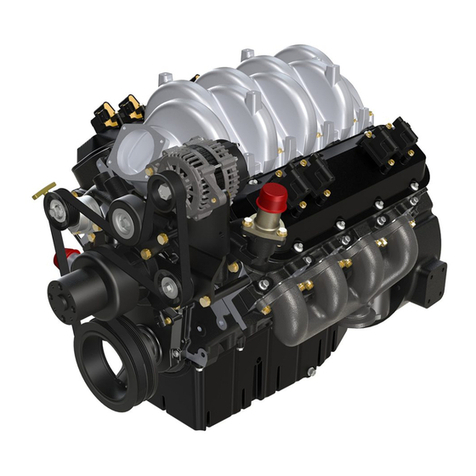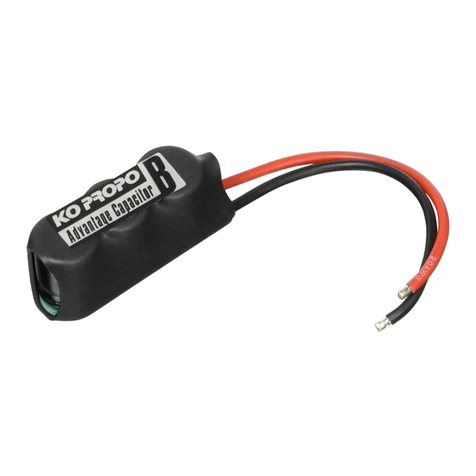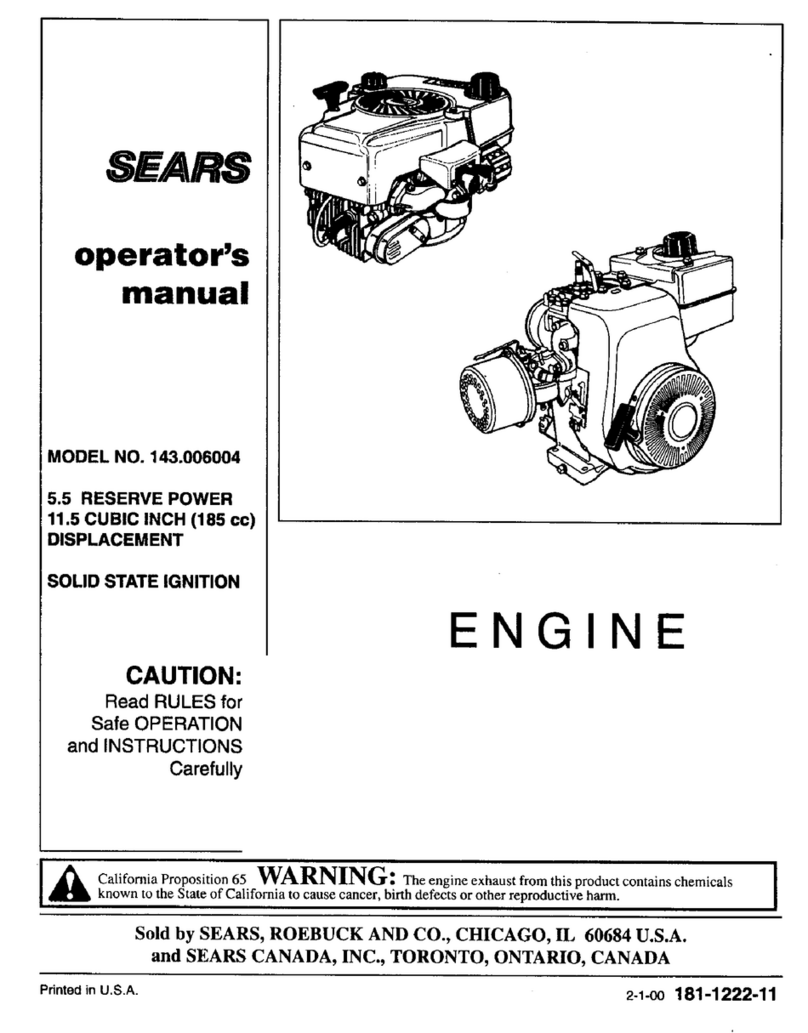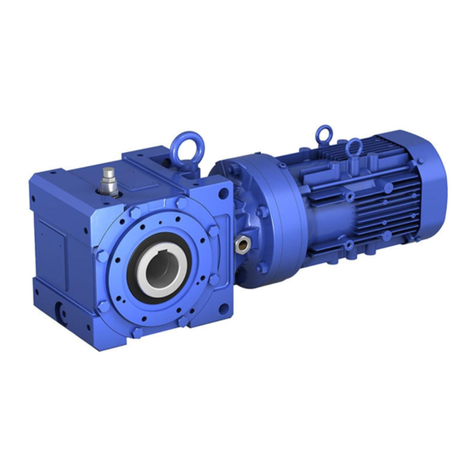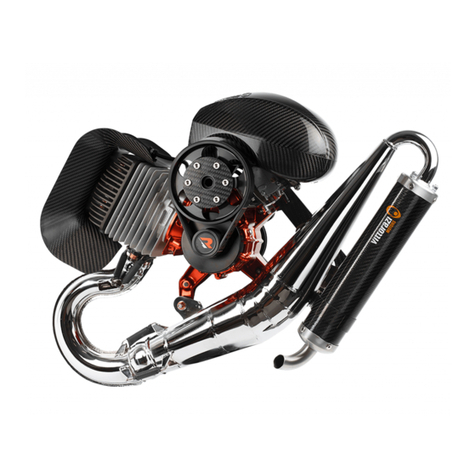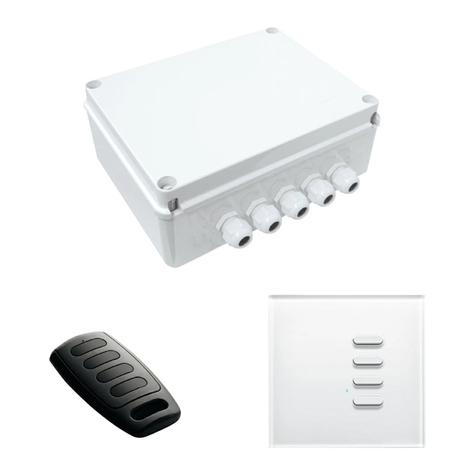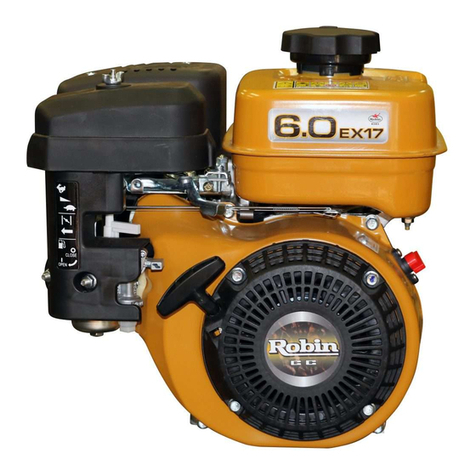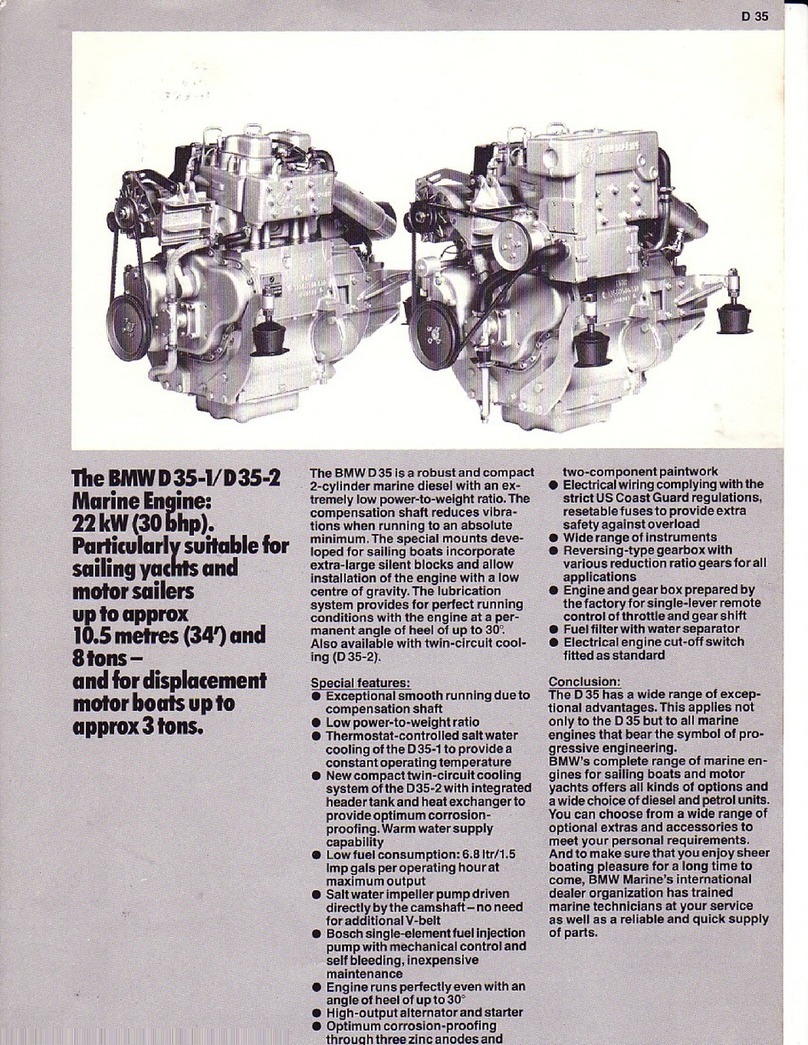PSI 8.8L LP User manual

Power Solutions International, Inc.
8.8L LP Engine Operation and Maintenance Manual
201 Mittel Dr.
Wood Dale, IL 60191
Power Solutions International, Inc.
US EPA & CARB HD-SI Certification
36100015 - Rev 4
May 2019

IMPORTANT
The information, specifications, and illustrations contained in this manual are based on data that was current at the time of
publication. Power Solutions International, Inc. reserves the right to make changes and/or improvements at any time
without notification, liability, or without applying those changes or improvements to vehicles previously manufactured and/or
sold.
NOTICE
Be
advised
that
this
motor
vehicle
may
be
equipped
with
computer
/
recording
devices.
Their
function
is
to
allow
an
authorized
individual
to
download
data
or
information
relating
to
the
operation
or
performance
of
this
vehicle.
The
stored
data
or
information
may
be
neither
downloaded
nor
retrieved
except
by
the
vehicle’s
registered
owner,
or,
in
the
alternative,
by
another
individual
or
entity
authorized
by
the
registered
owner,
(e.g.,
Certified
Service
Dealer)
who
may
need
this
data
or
information
to
properly
service
or
diagnose
this
vehicle
for
repair
or
following
an
accident.
Any
access
to
this
information
without
the
owner’s
consent
may
be
in
violation
of
law
and
may
subject
that
person
or
entity
to
criminal
penalties.

TABLE
OF
CONTENTS
FOREWORD 1
SAFETY INFORMATION 3
WARRANTY 9
EPA and CARB Emission System Warranty 9
Manufacturer's Warranty Coverage 9
Owner's Warranty Responsibilities 10
Warranty Exclusions 11
SECTION 1 – ENGINE SYSTEMS
Engine Serial Number 13
Engine Emission Label 14
Engine Accessories 14
Engine Specification 15
Engine Description 15
Engine Features 19
Engine Related Optional Features 20
Component Location – Top 23
Component Location – Front 24
Component Location – Left 25
Component Location – Right 26
Component Location – Rear 27
SECTION 2 – REQUIREMENTS FOR FUEL, ENGINE OIL, AND COOLANT
Fuel 29
Acceptable Fuel Blends 29
Unacceptable Fuel and Blends 29
Unsafe Practices 29

TABLE
OF
CONTENTS
Engine Oil
Engine Oil Quality and Service Categories
30
SAE Oil Viscosity Grade
30
30
Coolant
30
Coolant Mixtures
30
Contamination of Coolant
30
SECTION 3 – INSTRUMENTS, INDICATORS, AND SWITCHES
Instrument Panel Gauge Cluster
Warning Lamps 31
Wait to Start Lamp 31
Maintenance Lamp 31
31
Amber Warning Lamp (AWL) 31
RED Stop Lamp (RSL) 32
Malfunction Indicator Lamp (MIL) 32
Gauges
33
Typical Water Temperature Gauge 33
Oil Temperature Gauge 33
Oil Pressure Gauge 33
SECTION 4 – ENGINE OPERATION
Preoperation Checklist 35
Preparing the Fuel System 36
Starting the Engine 37
Emergency Starting 39

TABLE
OF
CONTENTS
Operation
40
Idle Speed 40
Cold Weather Operation 40
Hot Weather Operation 41
Engine Shutdown 41
Engine Warning Protection System (EWPS) 42
EMD Overview 43
Road Speed Governor (RSG) 43
Road Operation 43
SECTION 5 – MAINTENANCE SCHEDULE AND SERVICE PROCEDURES
Maintenance Schedule 45
Service Procedures 47
Oil Level 47
Coolant Level 48
External Leakage 49
Belt, Air Intake Piping and Clamps 50
Coolant Freeze Point 53
Engine Oil and Filter 53
Electrical System 55
SECTION 6 – LONG TERM STORAGE
General Information 57
SECTION 7 – SERVICE RECORDS
Maintenance Service Record 60
Daily Care and Report 61
APPENDIX 67

FOREWORD

FOREWORD
Page
1
Foreword
Power Solutions International, Inc. is committed to continuous
research and development to improve products and introduce
technological advances. Procedures, specifications, and
parts defined in published technical service literature may be
altered.
NOTE: Photo illustrations identify specific parts
or assemblies that support text and procedures; other
areas in a photo illustration may not be exact.
This manual includes necessary information and specifications
for operators to operate and maintain the PSI 8.8L LP engine.
Contact your dealer for more information.
Refer to the applicable technical service literature
Engine Service & Diagnostic Manual
Warranty Policy and Procedures Manual
Technical Service Literature is revised periodically. Use only
up-to-date service information.
To order technical service literature, contact your dealer.
All marks are trademarks of their respective owners.
About the Manual
This manual contains information needed to correctly operate
and maintain your engine as recommended by PSI.
Numerous
illustrations, symbols and feature descriptions are
used to aid in
understanding the meaning of the text. The
illustrations,
symbols or feature descriptions may not be
available for all
applications, please contact your dealer for
complete
information. Both metric and U.S. customary values
are listed
in this manual. The U.S. Customary value is listed
first,
followed by the metric value in brackets. For additional
service
literature refer to Service Literature noted in this
manual. This
manual does not cover vehicle or equipment
maintenance
procedures.
When referring to the left-hand or right-hand side of the
engine, this will be as viewed from the rear. (Looking at the
flywheel)
Consult the original vehicle or equipment manufacturer for
specific maintenance recommendations.

Page
2
SAFETY
INFORMATION

Page
3
SAFETY
INFORMATION
Safety Information
This manual provides general and specific
maintenance
procedures essential for reliable engine
operation and your
safety. Since many variations in
procedures, tools, and service
parts exist, advice for all
possible safety conditions and
hazards cannot be stated.
Read safety instructions before doing any service and test
procedures for the engine. See related manuals for more
information.
Obey Safety Instructions, Warnings, Cautions, and Notes in this
manual. Not following Warnings, Cautions, and Notes can lead
to injury, death, or damage to the engine or vehicle.
Safety Terminology
Three terms are used to stress your safety and safe operation of
the engine: Warning, Caution, and Note.
Warning: A warning describes actions necessary to prevent
or
eliminate conditions, hazards, and unsafe practices that can
cause personal injury or death.
Caution: A caution describes actions necessary to prevent or
eliminate conditions that can cause damage to the engine or
vehicle.
Note: A note describes actions necessary for correct, efficient
engine operation.
Safety Instructions
Work Area
•
Keep work area clean, dry, and organized.
•
Keep tools and parts off the floor.
•
Make sure the work area is ventilated and well lit.
•
Make sure a First Aid Kit is available.
Safety Equipment
•
Use correct lifting devices.
•
Use safety blocks and stands.
Protective Measures
•
Wear protective safety glasses and shoes.
•
Wear correct hearing protection.
•
Wear cotton work clothing.
•
Wear sleeved heat protective gloves.
•
Do not wear rings, watches or other jewelry.
•
Restrain long hair.

Page
4
SAFETY
INFORMATION
Vehicle
•
Shift transmission to park or neutral, set parking brake, and
block wheels before doing diagnostic or service procedures.
•
Clear the area before starting the engine.
Engine
•
The engine should be operated or serviced only by
qualified individuals.
•
Provide necessary ventilation when operating engine in a
closed area.
•
Keep combustible material away from engine exhaust
system and exhaust manifolds.
•
Install all shields, guards, and access covers before
operating engine.
•
Do not run engine with unprotected air inlets or exhaust
openings. If unavoidable for service reasons, put protective
screens over all openings before servicing engine.
•
If an engine is not safe to operate, tag the engine and ignition
key.
Fire Prevention
•
Make sure charged fire extinguishers are in the work area.
NOTE: Check the classification of each fire extinguisher
to ensure the following fire types can be extinguished.
1.
Type A — Wood, paper, textiles, and rubbish
2.
Type B — Flammable liquids
3.
Type C — Electrical equipment
Batteries
•
Always disconnect the main negative battery cable first.
•
Always connect the main negative battery cable last.
•
Avoid leaning over batteries.
•
Protect your eyes.
•
Do not expose batteries to flame or sparks.
•
Do not smoke in workplace.
Compressed Air
•
Use an OSHA approved blow gun. Limit blow gun air
pressure to 30 psi (207 kPa).
•
Wear safety glasses or goggles.
•
Wear hearing protection.
•
Use shielding to protect others in the work area.
•
Do not direct compressed air at body or clothing.

Page
5
SAFETY
INFORMATION
Tools
•
Make sure all tools are in good condition.
•
Make sure all standard electrical tools are grounded.
•
Check for frayed power cords before using power tools.
Fluids Under Pressure
•
Use extreme caution when working on systems under
pressure. Pay close attention when working with the fuel
system.
•
Follow approved procedures only.
Fuel
•
Do not smoke in the work area.
•
Do not refuel the tank when the engine is running.
Removal of Tools, Parts, and Equipment
•
Reinstall all safety guards, shields, and covers after
servicing the engine.
•
Make sure all tools, parts, and service equipment are
removed from the engine and vehicle after all work is done.
Propane Safety Instructions
Warnings:
•
Never loosen fittings or vent any propane. Escaping propane
can cause frostbite and severe freeze burns. Wear insulated
PVC rubber gloves resistant to propane, goggles for
protection against accidental release of pressurized
products, and thermal protective clothing when handling
refrigerated liquids.
•
Do not remove any valves, bulkheads, or fittings from a tank
unless the tank has been drained completely. The pressure
inside a propane tank can push a loosened bulkhead or
valve out with enough force to cause injury or death.
•
Keep all sources of ignition away from propane vehicles
while the fuel system is being serviced. Even if the tank and
fuel lines are empty, there may still be flammable vapors
near the vehicle.
•
Do not disconnect any propane hoses unless they have
been completely drained using the proper procedure.
•
Do not vent or release propane indoors or near sewers, pits
or low lying areas. Propane can accumulate in low spots,
creating a fire hazard. Propane can also displace oxygen,
creating a suffocation hazard.
•
Always unplug the fuel control box or disconnect the battery
before you work on any part of the fuel system.
NOTE: It is recommended that you obtain and read the
NFPA (National Fire Protection Association) #58, Standard
for the Storage and Handling of Liquefied Petroleum
Gases.

Page
6
SAFETY
INFORMATION
First Respondent and Operator Warning
Material ID Number: 1075
Guide Number: 115
NOTE: Please refer to Cautions and Warnings in the
PHMSA
Emergency Response Guidebook. (Pipeline and
Hazardous
Material Safety Administration)
1/4 Turn Safety Shut-Off Valve
The fuel system utilizes a manual shut-off valve to be used in
the case of an emergency.
The valve is located on the front of the left-hand side fuel tank
(driver's side). To operate the valve, grab firmly and pull the
valve down a 1/4 of a full turn (90°) until the tab on the lever
bottoms out on the dowel. This will manually stop fuel flow from
the tanks.
Refer to figure 1 to the right.
Figure 1 - 1/4 Turn Safety Shut-Off Valve

Page
7
SAFETY
INFORMATION
Propane Safety Specifications
Specification Item
Unit
Initial Boiling Point @ 14.7 psi
Weight per 1gal of liquid @ 60°F.
Ignition Temperature in Air
Air/Fuel Ratio by Volume
Air/Fuel Ratio by Weight
-44° (-42.2°)
4.24 (7.28)
920°-1,120° (493.3°-604.4°)
15.6:1
24:1
°F (°C)
lbs/gal (kg/L)
°F (°C)
Chemical Formula: C3H8

Page
8
WARRANTY

Page
9
WARRANTY
Warranty
EPA and CARB Emission System Warranty
WARRANTY PERIOD
Government agencies including the United States
Environmental Protection Agency (EPA) and the California Air
Resources Board (CARB) require Power Solutions International,
Inc. to provide emissions warranty to end users. PSI must
warrant the engine is designed, built and equipped so as to
conform at the time of sale with applicable regulations and be
free from defects in materials and workmanship for a defined
period of years or miles, whichever occurs first (Emissions
Warranty). PSI will provide emissions warranty coverage as
required by the EPA and CARB regulatory agencies. Emissions
Warranty does not cover, remanufactured, dealer rebuilt or
dealer exchange engines.
•
5 years
• 50,000 miles (80,467 km)
•
Or if covered by any basic or extended warranty (if greater
than above)
Your 8.8L LP engine conforms to U.S. Environmental
Protection Agency (EPA) regulations for emission systems.
The California Air Resources Board, United States
Environmental Protection Agency and Power Solutions
International, Inc. are pleased to explain the emission control
system warranty on your PSI 8.8L LP engine. In California, new
motor vehicles must be designated, built and equipped to meet
the State's stringent anti-smog standards. Power Solutions
International, Inc. warrants the emission control system on your
engine for the periods of time listed, provided there has been
no abuse, neglect or improper maintenance of your vehicle.
Your emission control system includes parts such as the LPG
fuel-injection system, the ignition system, catalytic converter,
and
engine computer. Also included may be hoses, belts,
connectors
and other emission-related assemblies.
Where a warrantable condition exists, Power Solutions
International, Inc. will repair your truck at no cost to you
including
diagnosis, parts and labor.
Manufacturer's Warranty Coverage
5 years or 50,000 miles (whichever first occurs):
1)
If your truck fails a Smog Check inspection, all necessary
repairs and adjustments will be made by Power Solutions
International, Inc. to ensure that your emission control system is
working properly. This is your Emission Control System
PERFORMANCE WARRANTY.
2)
If any emission-related part on your truck is defective, the
part will be repaired or replaced by Power Solutions
International, Inc. This is your short-term emission control
system DEFECTS WARRANTY.

Page
10
WARRANTY
Federal Emission System Warranty (cont.)
Owner's Warranty Responsibilities
As the truck owner, you are responsible for the performance of
the required maintenance listed in your Operation and
Maintenance manual. Power Solutions International, Inc.
recommends that you retain all receipts covering maintenance
on your truck, but Power Solutions International, Inc. cannot
deny warranty solely for the lack of receipts or for your failure to
ensure the performance of all scheduled maintenance.
You are responsible for presenting your truck to a certified
dealer
as soon as a problem exists. The warranty repairs should
be
completed in a reasonable amount of time, not to exceed 30
days.
As the truck owner, you should also be aware that Power
Solutions International, Inc. may deny you warranty coverage if
your truck or a part has failed due to abuse, neglect, improper
maintenance or unapproved modifications.
In the case of emergency when a warranted part or warranty
station is not reasonably available to you, repairs may be
performed at any available service establishment, or by you,
using any replacement part. Power Solutions International, Inc.
will reimburse you for your expenses including diagnostic
charges for such an emergency repair or replacement, which
cannot exceed Power Solutions International, Inc's suggested
retail price for all warranted parts replaced and labor charges
based on Power Solutions International, Inc's recommended
time
allowance for the warranty repair and the geographically
appropriate hourly labor rate.
All receipts and failed parts must be kept in order to receive
compensation for warranted repairs reimbursable due to an
emergency.
If you have any questions regarding your warranty rights and
responsibilities, you should contact Power Solutions
International, Inc. at 888-331-5764 or the California Air
Resource Board at 9528 Telstar Avenue, El Monte, CA 91731.

Page
11
WARRANTY
Federal Emission System Warranty (cont.)
WARRANTY EXCLUSIONS
The following items are not reimbursable under the PSI warranty
terms.
•
Any repair on an engine that has exceeded the hour or time
limitation of the stated warranty.
•
PSI may deny any claims that in their sole discretion are the
result of misapplication of the engine or part.
•
Units that are under development (i.e. prototype projects,
engineering projects).
•
Any repair on an engine where the hours of operation or in-
service date has been misrepresented.
•
Any repair on an engine if the hour meter has been altered
so that the true hours on the engine cannot be determined.
•
Any repair on an engine where the date of service has been
misrepresented to place an out-of-warranty engine inside the
warranty period.
•
Engines damaged by an Act of God or force majeure.
•
Routine maintenance repairs.
•
Repairs required due to improper storage precautions.
•
Adjustments made to improve performance beyond PSI
estimated normal standards.
•
Use of other than genuine OEM parts, unless in an
emergency situation.
•
Any failure that is a result of the application and not a defect
in the materials or workmanship from PSI as deemed by PSI.
•
Repairs to parts that, upon analysis, are found not to
be defective.
•
Repairs to engines used for re-powering on-road vehicles.
•
All consequential expenses, including, but not limited to,
those
resulting from equipment failure such as lodging, food,
downtime or replacement equipment rental.
•
Any misapplication or misuse of the product as deemed
by PSI.
•
Towing or transportation expense for moving an engine or
engine-powered equipment from the customer location to the
repair location.
•
Repairs caused by damage due to poor workmanship.
For additional warranty information please refer to the "Power
Solutions International Warranty Policy and Procedures
Manual".

Page
12
SECTION
1
–
ENGINE
SYSTEMS

Page
13
SECTION
1
–
ENGINE
SYSTEMS
Engine Serial Number
The engine serial number can be found in two locations.
The serial number label will be located on the right-hand side
valve cover as shown in figure 3.
The number will also be stamped on the left-hand side of the
engine, near the flywheel as shown in figure 4.
Engine Serial Number Examples
8.8L12345
Engine Serial Number Codes
8.8L - Engine Displacement
12345 - Engine Serial Number
Figure 2 - Serial Number Label Example
Figure 3 - Serial Number Label Location
Figure 4 - Stamped Location of Serial Number

Page
14
SECTION
1
–
ENGINE
SYSTEMS
Engine Emission Label
The U.S. Environmental Protection Agency (EPA) exhaust
emission label is attached to the plate on top of the intake
manifold as shown in figure 6. The EPA label typically includes
the following:
•
Model year
•
Engine family and displacement
•
Advertised horsepower rating
•
Emission family and control systems
Figure 5 - Emission Label Example
Engine Spec Label
There will also be an Engine Spec Label that contains the spec
description, spec number, and an engine spec barcode. This
will be located on the plate mounted to the top of the intake
manifold as shown in figure 6.
Engine Accessories
The following engine parts may have manufacturer's labels or
identification plates:
•
Alternator
•
Compressor
•
Engine Control Module
Figure 6 - Engine Spec Label
Table of contents
Other PSI Engine manuals
Popular Engine manuals by other brands

Perkins
Perkins 4016-61 TRG Operation and maintenance manual
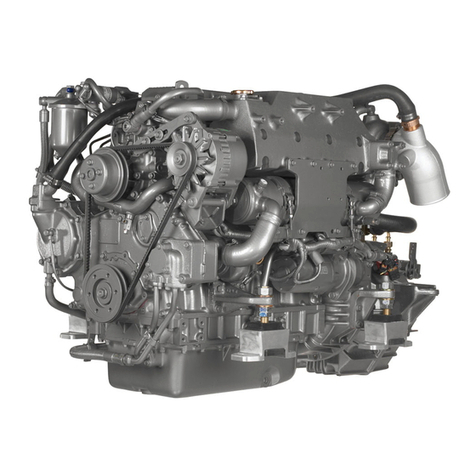
Yanmar
Yanmar 4LHA-HTP Operation manual
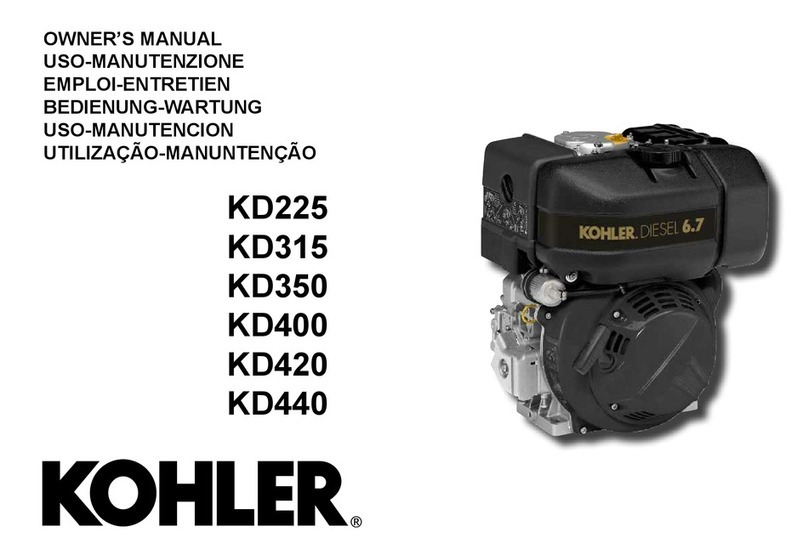
Kohler
Kohler KD225 owner's manual
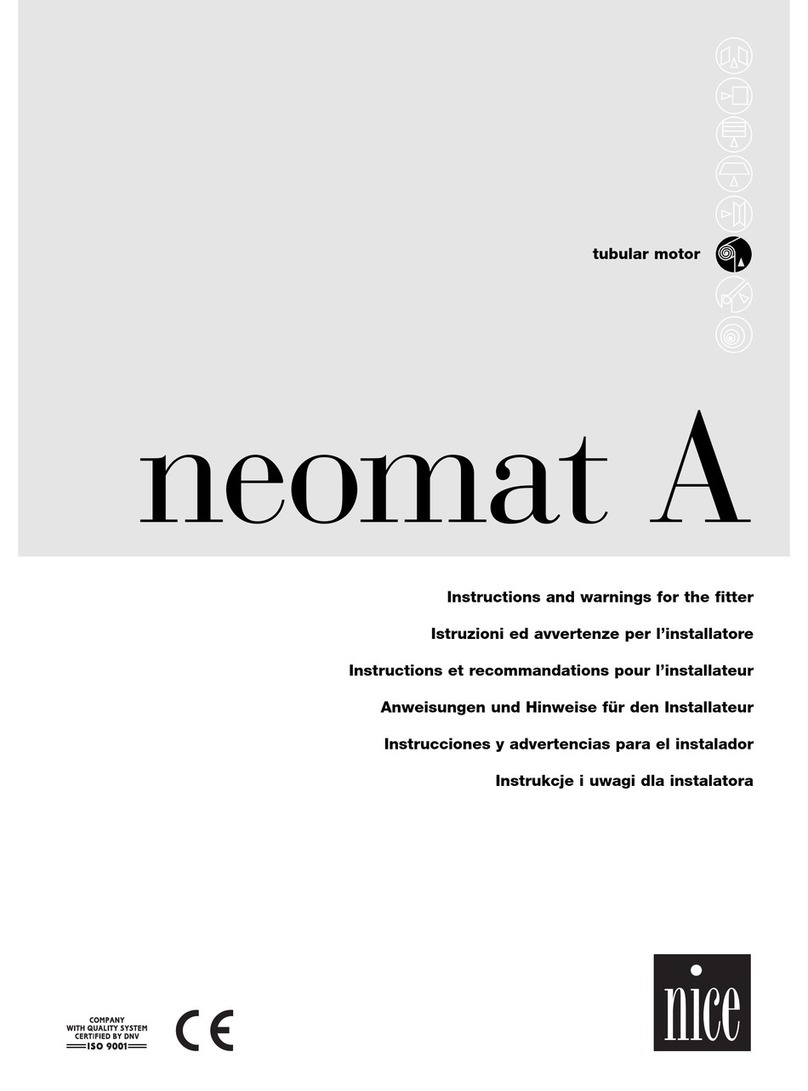
Nice
Nice Neomat A Series Instructions and warnings for the fitter

Detroit Diesel
Detroit Diesel 8 V 4000 M60 R operating instructions

Kohler
Kohler Aegis 05810334 Service manual
